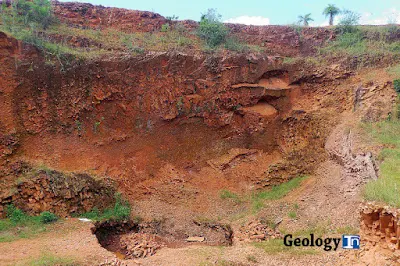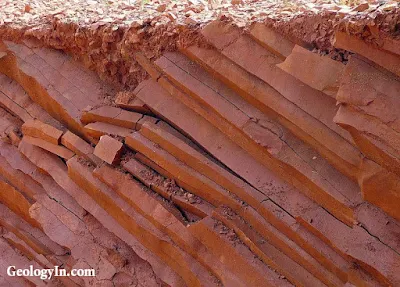Columnar Sandstone Structure
Columnar sandstones are a rare and intriguing geological formation where sandstone fractures into vertical, prismatic columns that resemble giant pencils or organ pipes. These columns can range from just a few centimeters to several meters in diameter and may reach heights of up to 15 meters.
Unlike the more common columnar jointing in volcanic rocks like basalt—which forms due to the thermal contraction of cooling magma—columnar jointing in sandstone is much rarer and results from complex diagenetic and hydrothermal processes.
There are only a few known localities worldwide where such features occur, including Canada, South Africa, Paraguay, Egypt, and Israel.
 |
| Polygonal sandstone columns formed by rapid cooling and hydrothermal processes. |
Columnar Sandstone in Luque, Paraguay
In Eastern Paraguay, the Patiño Formation sandstones outcropping near the Areguá neighborhood exhibit spectacular columnar jointing adjacent to a 0.8 m-thick nephelinite dyke. These sandstone columns form orthogonally to the dyke walls and vary in angle from 10° to 60°, with 40–50° being the most common. Column diameters range from 3 to 10 cm, and some reach up to 15 meters in length.
 |
| Columnar jointing in sedimentary rock caused by magma-induced thermomechanical stress. |
Formation Mechanism
The formation of these joints is linked to rapid heating and cooling associated with magma intrusion. Thermal expansion followed by rapid contraction caused internal stress, leading to polygonal cracking. This process produced a network of joints that nucleated first on cooler isothermal surfaces and propagated inward toward the heat source.
The resulting polygonal columns are thought to have formed by thermal contraction, similar to basalt columnar jointing, but under very different physical and chemical conditions due to the sedimentary nature of the host rock.
 |
| A pile of columnar jointing sections next to an active quarry face, where water facilitates rock exfoliation. |
Textural Features
The sandstone displays a high proportion of syntaxial quartz overgrowth, with porosity developed through both dissolution and fracturing.
Floating grains in the cement, interpenetrative grain-cement contacts, and intense fracture porosity indicate that quartz cementation occurred in situ, primarily via dissolution–reprecipitation driven by rapid thermal changes.
These features suggest that magma intrusion provided the heat necessary to mobilize silica in pore fluids, causing localized quartz dissolution followed by reprecipitation during cooling.
Field view of reddish eolian sandstone with vertical joints from thermal alteration. |
Formation Mechanism of Columnar Joints
The injection of the nephelinite dyke caused a thermal gradient in the surrounding sandstone. As the rock was heated and then cooled, thermomechanical stresses accumulated.
Internal tension led to the nucleation of polygonal cracks, creating prism-like columns joined by orthogonal fracture systems.
Cracking initiated along lower-temperature isotherms and propagated toward the dyke, following thermal gradients.
The columns are orthogonal to the dyke margins and vary in inclination between 10° and 60°, most commonly 40–50°. Column diameters range from 3 to 10 cm, with lengths up to 15 meters.
 |
| Columnar sandstone formations at Marambu Quarry, showcasing natural fracture patterns. |
Mineralogical Indicators
The initial cement appears to be a low-crystallinity silica phase, rapidly precipitated under intense dissolution–reprecipitation conditions.
The presence of fluid inclusions suggests a hydrothermal event, likely driven by rapid increases in temperature and/or pH from the magmatic intrusion.
Mineralogical and Textural Features
Close to the dyke, the Patiño sandstones exhibit:
- Syntaxial quartz overgrowths
- Floating grains within silica-rich cement
- Intense fracture porosity
These features indicate that hydrothermal alteration occurred. Heated interstitial fluids—likely derived from the magma—triggered dissolution and reprecipitation of quartz, causing the low-crystallinity cement to form in situ.
 |
| Rare columnar sandstone formation resembling basalt columns, Luque, Paraguay. |
Global Rarity of Columnar Sandstones
While columnar joints are common in volcanic rocks, they are extremely rare in sandstones. Besides Paraguay, notable examples include:
- South Africa (Clarens Formation)
- Canada (Brittany Sandstone, Nova Scotia)
- Egypt & Israel (Nubian Sandstone)
Implications and Uniqueness
The columnar joints of the Cِi and Chororó Hills in Paraguay are among the very few known examples of this phenomenon in sandstones. They represent a unique interaction between igneous and sedimentary processes, where thermal and chemical alterations induced by dyke intrusion mimic—but are not identical to—the mechanisms of columnar jointing in lava flows.
This discovery challenges conventional assumptions that columnar jointing is exclusive to igneous rocks and highlights the complex interplay between sedimentary rock fabrics, fluid-rock interactions, and thermomechanical stress.
 |
| Vertical columnar joints in reddish eolian sandstone formed by thermal contraction near a nephelinite dike. |
Comparison to Igneous Columnar Jointing
The proposed formation mechanism for the Areguá columnar sandstones differs significantly from that in igneous rocks. While columnar basalt forms over long durations via convective cooling throughout a magma body, the Paraguayan columns formed rapidly, controlled by localized heating and thermal contraction of already lithified sandstone.
 |
| Columnar sandstone formations in Makhtesh Ramon, Negev Desert, Israel, displaying hexagonal jointing patterns. Photo by siimsepp. |
The columnar sandstones of Paraguay are a striking example of how igneous intrusions can dramatically alter sedimentary rocks through heat-driven processes. Their formation is a testament to the dynamic interplay between thermal stress, fluid chemistry, and brittle fracturing—a rare and captivating geologic story.
All the photos were taken by Ron Halliday.


%20(1).webp)





